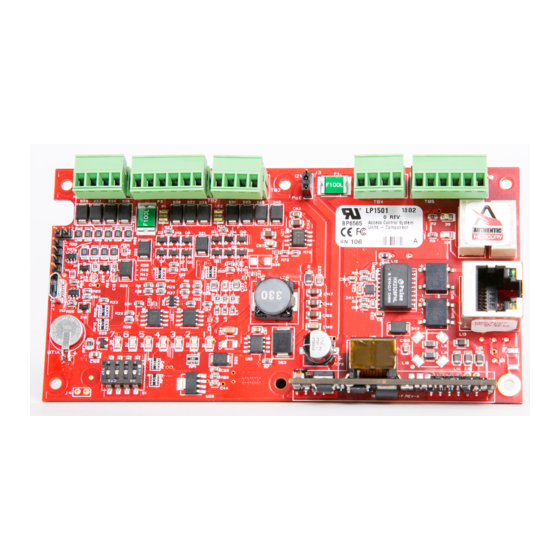Advertisement
LP1501 Intelligent Controller
with Paired Reader Interface for One Physical Barrier
Installation and Specifications:
1. General:
The LP1501 intelligent controller provides decision making, event reporting and database storage for the
Mercury hardware platform. Two reader interfaces configured as paired or alternate readers provide
control for one physical barrier.
Host communication is via the on-board 10-BaseT/100Base-TX Ethernet port.
Note: For UL compliance, the Power Sourcing Equipment (PSE) such as a PoE or PoE+ enabled network
switch and/or PoE or PoE+ power injectors must be UL Listed under UL294B.
Reader port 1 can accommodate a reader that utilizes TTL (D1/D0, Clock/Data), F/2F, or 2-wire RS-485
device signaling (for example an OSDP reader), also provides tri-state LED control, and buzzer control
(one wire LED mode only). This port can also utilize multiple 2-wire RS-485 multi-dropped devices, such
as up to two OSDP readers or up to eight remote serial I/O devices.
Reader port 2 can accommodate a reader that utilizes TTL (D1/D0, Clock/Data), or F/2F signaling, also
provides tri-state LED control, and buzzer control (one wire LED mode only). Two Form-C contact relay
outputs may be used for door strike control or alarm signaling. The relay contacts are rated at 2 A @ 30
Vdc, dry contact configuration. Two inputs are provided that may be used for monitoring the door contact,
exit push button or alarm contact. Input circuits can be configured as unsupervised or supervised. The
LP1501 requires Power over Ethernet (PoE or PoE+) or 12 Vdc for power. The LP1501 may be mounted
in a 3-gang switch box; a mounting plate is supplied with the unit, or may be mounted in an enclosure; the
supplied mounting plate has mounting holes that match the MR50 mounting footprint.
2. LP1501 Hardware:
J7: TAMPER
SWITCH
CONNECTION
J5: Micro
USB JACK
J8: microSD CARD
(back side)
Ø .125 [Ø3.175]
6 PL
Mercury Security © 2018
2355 MIRA MAR AVE. LONG BEACH, CA 90815-1755, (562)986-9105 FAX (562) 986-9205
5.40 [137.16]
2.55 [64.77]
1
1
1
TB1
TB2
TB3
J7
7
6
5
4
3
2
1
4
3
2 1
V
ON
S1
DIP SWITCHES
LP1501 Layout
LP1501
DOC 10107-0064
This device complies with part 15 of the FCC Rules. Operation
is subject to the following two conditions: (1) This device may
not cause harmful interference, and (2) this device must
accept any interference received, including interference that
may cause undesired operation.
J3: PoE/12Vdc
POWER SELECTOR
JUMPER
2.55 [64.77]
1
1
J3
12V
TB4
TB5
PoE
K1
K2
STATUS LEDs
EARTH GND
REV 1.01
www.mercury-security.com
.15 [3.81]
J6: ETHERNET
CONNECTOR
.20 [5.08]
Page 1
Advertisement
Table of Contents

Summary of Contents for Mercury Security LP1501
- Page 1 Input circuits can be configured as unsupervised or supervised. The LP1501 requires Power over Ethernet (PoE or PoE+) or 12 Vdc for power. The LP1501 may be mounted in a 3-gang switch box; a mounting plate is supplied with the unit, or may be mounted in an enclosure; the supplied mounting plate has mounting holes that match the MR50 mounting footprint.
- Page 2 Jumpers: JUMPERS SET AT DESCRIPTION Factory Use Only LP1501 powered from the Ethernet connection LP1501 powered from an local 12 Vdc power source connected to TB4-3 (VIN), TB4-4 (GND) Factory Use Only Micro USB port (2.0) 10-Base-T/100Base-TX Ethernet Connection Cabinet Tamper Switch Input: short = tamper secure microSD Card Mercury Security ©...
-
Page 3: Input Power
2. Apply power to the LP1501 board. LED 1 on for about 15 seconds while LP1501 boots up. 3. After the LP1501 boots up, watch for LEDs 1 & 2 and 3 & 4 to alternately flash at a 0.5 second rate. -
Page 4: Communication Wiring
2000 ft. (610 m). Do not terminate any RS-485 devices connected to reader port 1. When powering remote device(s) from the LP1501, be cautious not to exceed the maximum current limit. Cable gauge must also be evaluated. See specifications section for details. - Page 5 FIRST READER PORT OSDP PROTOCOL DEVICE OSDP PROTOCOL DEVICE ADDRESS 0 ADDRESS 1 CLK/D1 9600 BAUD 9600 BAUD (DEFAULT) (DEFAULT) DAT/D0 Reader Port 1 - OSDP Protocol Devices (2-Wire RS-485) Mercury Security © 2018 LP1501 DOC 10107-0064 REV 1.01 Page 5...
- Page 6 Door lock mechanisms can generate EMF feedback to the relay circuit that can cause damage and premature failure of the relay plus affect the operation of the LP1501. For this reason, it is recommended that either a diode or MOV (metal oxide varistor) be used to protect the relay. Wire should be of sufficient gauge to avoid voltage loss.
-
Page 7: Memory Backup Battery
Upon installation, the user accounts to the web configuration page should be created with secure passwords, and that all DIP switches are in the off position for the normal operating mode. The LP1501 is shipped from the factory with a default login account, which is enabled when DIP 1 is moved from OFF to ON. -
Page 8: Specifications
2000 ft. (610 m) maximum Alarm Input: 1 twisted pair per input, 30 ohm maximum Outputs: As required for the load Environmental: Temperature: Storage -55 to +85 °C Operating 0 to +70 °C Mercury Security © 2018 LP1501 DOC 10107-0064 REV 1.01 Page 8... - Page 9 Leviton: part number 84033-40 Graybar: part number 88158404 Magnetic switch set: G.R.I. part number: 505 OPTIONAL BLANK COVER W/SCREWS OPTIONAL MAGNETIC TAMPER SWITCH LP1501 WITH INCLUDED MOUNTING PLATE OPTIONAL 3-GANG JUNCTION BOX TO ETHERNET FIELD WIRING NETWORK Mercury Security © 2018...
- Page 10 This product is not intended for, nor is rated for operation in life-critical control applications. Mercury Security is not liable under any circumstances for loss or damage caused by or partially caused by the misapplication or malfunction of the product. Mercury Security’s liability does not extend beyond the purchase price of the product.





Need help?
Do you have a question about the LP1501 and is the answer not in the manual?
Questions and answers